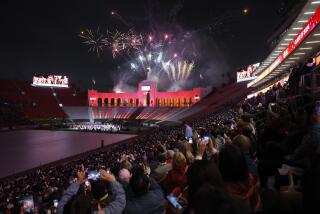Watermelon Given Heave-Ho in Messy Campus Tradition
- Share via
LA JOLLA — It shall be noted that Friday’s 36th annual Watermelon Drop at UC San Diego was a good Watermelon Drop, although not a record-breaking one.
This is serious stuff. The Watermelon Drop is the oldest tradition on this youngish campus of tall trees and modern architecture.
It began in 1965 when physics professor Bob Swanson asked his students to calculate the terminal velocity and “splatter range”--the distance between where the watermelon hits and where the farthest seed is flung--of a watermelon dropped from the seventh floor of the science building.
From this physics-can-be-fun beginning has evolved an annual event that signals the end of spring quarter and the commencement of final exams.
University life, of course, is replete with contests that mix silliness with science: the egg-drop festival at Cal State Fullerton, the walk-on-water challenge at the University of San Diego, and Ditch Day at Cal Tech, among others.
At a campus like UC San Diego, where the brainpower is sizable--the average freshman enters with a 3.99 grade-point average--and the drive to succeed is intense, the Watermelon Drop, which is preceded by a Watermelon Festival and followed by a Watermelon Feed, is a needed diversion before the grimness of finals.
“It’s a release,” said history professor Michael Parrish from a vantage point well outside splatter range.
Even in their fun, however, UC San Diego students prefer to keep statistics and records and apply the scientific method. No sense going totally out of character.
At 79 feet 9 inches, the splatter range of the watermelon dropped on Friday fell far short of the record 1974 splat of 167 feet 4 inches. Truth be known, it was even short of the inaugural splat of 91 feet in 1965. The terminal velocity, as always, was 112 mph.
Debate immediately broke out among the assembled science majors about whether the shortfall is evidence that watermelon rinds are getting tougher or concrete is getting softer.
Seth Raphael, a freshman serving as Watermelon Queen, was suitably royal in watermelon helmet and seed-like facial paint. His watermelon magic act helped him best another candidate who performed watermelon karate, slicing a watermelon in half.
Still, only time will tell if Raphael wins a spot alongside Bill Clabby, the 1979 Watermelon Queen whose outrageously oversized sunglasses are remembered still.
“This is one final moment of fun before the crunch hits,” said Raphael, who is alternating his academic interest between dramatic arts and computer science.
Hallie Taylor, a former UC San Diego student, returned to campus from West Virginia to watch her son reign over the Watermelon Drop. She took pictures lest her neighbors refuse to believe what college students do in California.
Unfortunately, the Watermelon Queen’s release of the oval-shaped fruit from the top of Urey Hall was somewhat short of the announced time of 10 minutes past noon. As a result, some students who had scurried across this expansive campus arrived when the pulpy fruit was already spread across the concrete.
“Outrageous,” said freshman Sam Litvin, clutching a copy of Boccaccio’s “Decameron”--that sometimes somber, sometimes licentious tale of love and Black Death that has long been an undergraduate favorite.
Some students watched the drop as they paused between classes; others arrived early and waited patiently.
Steve Bond, a researcher in the computational chemistry department, was there to check his calculation that it would take 2.25 seconds for the fruit to hit the pavement. Other people were just intrigued with the spectacle.
“I just wanted to see something go splat,” said Keith Conrad, assistant professor of mathematics.
More to Read
Sign up for Essential California
The most important California stories and recommendations in your inbox every morning.
You may occasionally receive promotional content from the Los Angeles Times.













